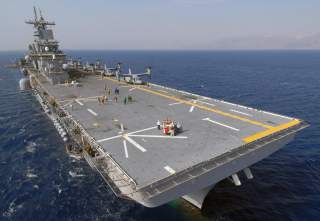The U.S. Marines Might Be Souring on Amphibious Assault Ships. Here's Why.
Welcome to an A2/AD world.
The incoming commandant of the U.S. Marine Corps is backing away from the service’s longstanding requirement for 38 dedicated amphibious assault ships.
The move could signal the beginning of a new approach to amphibious warfare for the world’s leading marine force.
New commandant Gen. David Berger is “willing to shed some key tenets of the Marines’ amphibious force-planning in recent years – including the demand for 38 amphibious warships to support a two Marine Expeditionary Brigade-sized forcible entry force,” Megan Eckstein reported for the U.S. Naval Institute.
Force-structure assessments in 2009 and 2016 affirmed the Marines’ requirement for 38 assault ships including LHA and LHD big-deck vessels and small-deck LSDs and LPDs.
The Navy in 2019 was short of the 38-amphib goal. The 32 ships currently in the fleet together can carry hundreds of jump jets, tiltrotors, helicopters, ACV armored vehicles, LCU landing craft and LCAC hovercraft as well as thousands of Marines.
“We will no longer use a ‘2.0 MEB requirement’ as the foundation for our arguments regarding amphibious ship building, to determine the requisite capacity of vehicles or other capabilities, or as pertains to the Maritime Prepositioning Force,” Berger wrote. “We will no longer reference the 38-ship requirement memo from 2009, or the 2016 Force Structure Assessment, as the basis for our arguments and force structure justifications.”
A new force-structure assessment due to end in 2019 could reduce the number of traditional assault ships in the Marines require and instead include alternative vessels in the tally of ships that can support a beach assault.
“The global options for amphibs include many more options than simply LHAs, LPDs and LSDs,” Berger wrote. “I will work closely with the secretary of the Navy and chief of naval operations to ensure there are adequate numbers of the right types of ships, with the right capabilities, to meet national requirements.”
The Marines in recent years have practiced staging from naval auxiliary vessels including trimaran transports, cargo ships and huge expeditionary sea bases that the Navy based on commercial tanker design.
The auxiliaries are numerous and cheap to operate but lack the weaponry and toughness of old-style assault ships. Including auxiliaries in force-planning could compel the Marines and Navy to reimagine how they would assault an enemy beach.
Increasingly powerful anti-ship missiles and other enemy defenses already pose a significant threat to assault ships. They could be even more dangerous for lightly-built auxiliaries and could force an assault force to stage farther from enemy territory.
“I do not believe joint forcible entry operations are irrelevant or an operational anachronism,” Berger acknowledged. “However, we must acknowledge that different approaches are required given the proliferation of anti-access/area denial threat capabilities in mutually contested spaces.”
“Visions of a massed naval armada nine nautical miles off-shore in the South China Sea preparing to launch the landing force in swarms of ACVs, LCUs, and LCACs are impractical and unreasonable,” he wrote. “We must accept the realities created by the proliferation of precision long-range fires, mines and other smart-weapons, and seek innovative ways to overcome those threat capabilities.”
Robotic ships could play a role, Berger wrote. “I encourage experimentation with lethal long-range unmanned systems capable of traveling 200 nautical miles, penetrating into the adversary enemy threat ring, and crossing the shoreline – causing the adversary to allocate resources to eliminate the threat, create dilemmas, and further create opportunities for fleet maneuver.”
Not coincidentally, the Navy has begun developing robotic surface warships and submarines. Neil Zerbe, a retired Navy officer, argued that the Navy also should buy unmanned cargo vessels for shuttling supplies from ship to shore in the aftermath of an amphibious assault.
“While many functions are important in an amphibious assault, once the assault is underway and Marines are on the beach, logistics is the critical factor in ensuring their success,” Zerbe wrote. “The operation will often only succeed if the Marines are able to have rapid, reliable and continuous resupply. Using manned naval craft to do this puts operators and vessels at unnecessary risk.”
David Axe serves as Defense Editor of the National Interest. He is the author of the graphic novels War Fix, War Is Boring and Machete Squad.

